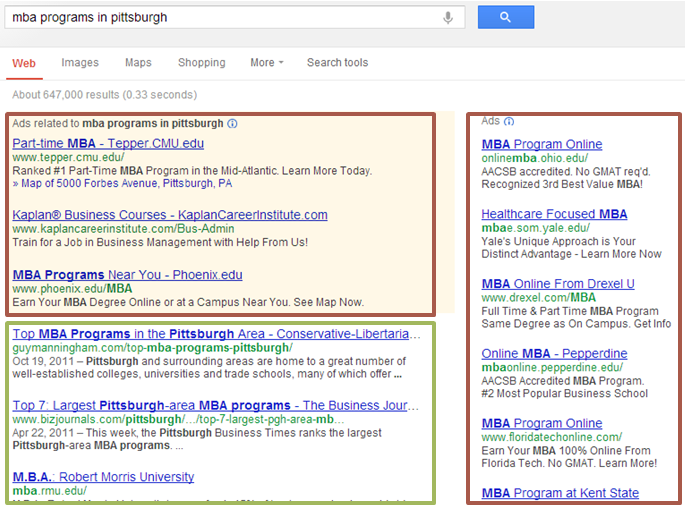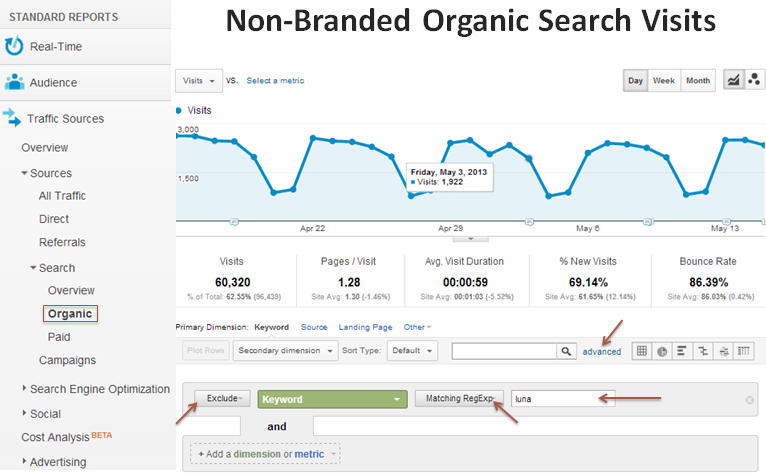Why Is Non‑Branded Organic Search Traffic An Essential SEO KPI?
Like every industry, SEO has its own vernacular and acronyms that can be terribly confusing to outsiders. We use 301 as a verb, crave link juice, scoff at EMDs and worship non-branded organic. Even worse, these terms are here to stay. SEO has cemented itself as an essential online marketing function. An expanded digital audience depends on an expanded digital vocabulary.
What is a Non-Branded Organic Search Visit?
In order to answer that question, let’s start at the beginning, which is actually the end: a visit. Don’t be embarrassed if this is new territory. It was not long ago that even the most savvy Internet marketers focused on hits. But for most people that has changed. Now we talk about a broader metric called visits. In Google Analytics, a visit includes most things that a person does during their stay on your website because a broader perspective than simply pageviews provides more insight to user (and prospective client) behavior. If you would like to learn more about visits, particularly how they begin and end, click on the screenshot below.

Now we understand that a visit can include multiple pageviews and actions on our website. The first step is complete. Let’s continue working backwards. A search visit is any visit that comes from a search engine. A search visit can come from two places: paid search and organic search. Paid search refers to an advertisement in the search results. The ads are shown in the red boxes below. Everything in the green, the non-paid listings, is organic.

That takes us to organic search visits. We are ¾ of the way there! To view organic search visits in Google Analytics, look in the Standard Reports menu for Traffic Sources -> Sources -> Search. You should see a graph and table of visits that arrived from a search engine but did not pay.
Non-branded organic search visits remove your brand name. Any visitor that uses your brand name in Google or Bing already knows where they want to go and are simply using a search engine to get there. SEOs remove that group because we want to know about the people who did not know where they would end up when they opened a browser. They had a question or need, asked a search engine for guidance and that interaction brought them to you. Of the the 30 trillion pages in Google’s index, they found and chose yours!
There three ways to find non-branded organic search visits. You use the following screenshot and instructions as a reference or skip to bottom for a free custom report that does most of the work. Wait! Before you scroll away, don’t you think it would be helpful to understand the process? It’ll only take a minute.

As you might be able to see above, you should first click the advanced link in the menu below the graph. That gives you the extra options that we need to remove your brand. Let’s start on the left and work our way right. Toggle Include so it says Exclude, which means it is removing the keyword from the dataset. Click Continue and select Matching RegExp. Curiosity there is a whole new chapter so check out Robbin’s ebook on regular expressions everything you would ever need to know.
In the space next to Matching RegExp, you must enter your brand name. This might take a bit of guess-and-check work but it is best to select the most common portion of it. For example, I will use “luna” for LunaMetrics because people rarely misspell that portion of it. “Luna” collects searches for “Luna” and “LunaMetrics” and “luna metrics” and “luna matrix” and so on.
That’s it! Click Apply to view non-branded organic search traffic or, in other words, all of the visits that arrived at your website without using an ad or your name.
Other SEO Key Performance Indicators
There are lots of vital SEO metrics. Reid discusses many of them in his post on SEO KPIs for lead generation. Reciting them here would be a disservice because he explains them as well as anyone. Specifically, he addresses:
- Referral traffic from link building
- Return on investment (ROI)
- Non-branded organic search conversions
That last one is really important. What is the value of 100,000 visits if they all bounce from your website without converting? Sure, brand building is worth something, but probably not enough to pay your salary.
SEO Custom Report for Google Analytics
As promised, here is the custom report that you can save in your Google Analytics profiles. Remember to add your brand before you use them! The steps for adding your brand (so you can remove it from the report) are outlined in that final screenshot. Please use the comments if you have any trouble.
Non-Branded Organic Search Custom Report for Google Analytics

Click the one of the custom reports and select the profile to which you would like to add it. To access it, select Customization in the top orange bar. Open the report and click the Edit button in the gray bar below the report title. That should deliver a screen that resembles the one above. Scroll to the final filter. That’s the one we need to change. Right now it says “INSERT BRAND HERE.” Please refer to the bold paragraph half way up the page for tips on creating a branded Regular Expression. After creating a branded term, select Save to finalize the custom report. From now on, all of that non-branded search data will be a couple clicks away.


